This newest film, recently finished and now making its way to film festivals and screenings, is an hour-long documentary about the innovative ways in which coastal and port cities, mostly in the US, are managing the marine and aquatic habitats around them. The resulting film is at once informative and inspirational, telling some of the emerging stories of actions taken by local governments and NGOs to connect with marine nature, to understand it as an asset, but also to manage and prepare for the dangers associated with proximity to water. I often find myself speaking of the “dangers and delights” of coastal urban settings, and we’ve tried in this film to present the good work of cities to address both issues (two sides of the same coin really).
This is the second major film collaboration with Colorado filmmaker Chuck Davis. It began with an earlier film called The Nature of Cities (pre-dating and unrelated to the creation of the TNOC blog; the entirely of which can now we watched online here: https://vimeo.com/98080426). It was a serendipitous collaboration: we met by chance at a green building conference in Utah. Chuck was screening his latest film, Transforming Energy, and I was giving a talk about work around Green Urbanism. Chuck approached me after this talk and suggested we think about a film that would document and present in compelling visual ways the innovative green cities I was studying. With just a little funding, Chuck and I (and usually one camera man) travelled and filmed in a number of American and European cities, including San Diego, Austin, New York, Copenhagen, Stockholm, Amsterdam, Freiburg, and Paris. It was a dizzying array of stories and voices and to Chuck’s credit he was able to brilliantly weave these strands together to produce an informative and entertaining film, one seen by PBS viewers around the country.
I highly recommend such collaborations, though in the Urban Planning world they seem unusual. It has been an especially potent joining of a filmmaker’s / director’s (Chuck) technical and creative skills with my professional and scholarly knowledge and contacts. It was an epiphany to me as mostly a researcher and academic to begin to understand the power of film in vividly showing what cities could be and what they were striving to accomplish. I had written (and continue to write) books about these leading cities, but have become convinced that telling their stories in this more sensorially rich way has tremendous value.
Our film shoots have been largely low-budget. Mostly it is the cost of travel that is required. At every point we have found creative ways to capture memorable scenes on a low budget. In Copenhagen we filmed on-bicycle interview with the head of the city’s bicycle planning efforts. It was a bit a coordination test for me, the interviewer, and creative equipment solution was found with the use of one of that city’s famous cargo bikes: the cameraman was crouched in the front, with the director frantically pedaling to keep up.
Ocean Cities is similar in strategy and format. Largely unscripted, with interactions on-site, designers, local official, and citizens talk about what we are seeing and share their opinions and perspectives. We’ve been able, I think, to capture the remarkable vitality and beauty of these waterfronts and to embed within specific cities compelling stories of what is possible. The film builds on my own earlier work around the concept of Blue Urbanism[i] (see also this.) The main premise is that we live on the blue planet (more than 70 percent of the surface of the Earth is water) and increasingly the urban planet—yet these two spheres seem rarely connected.
The Trailer for our 50 minute documentary film Ocean Cities. Click to Watch!
While we need to appreciate and plan for the danger, delight is everywhere in such ocean cities. We film opens with a walk along the beach at Carmel with J. Nichols, author of the book Blue Mind, talking about the psychological and stress-reducing benefits of water. The backdrop here makes the point wonderfully, a key premise of our filmmaking approach. This was true at many points in the filming: interviewing kids from an underserved neighborhood in Baltimore as they learned to kayak (and doing the interviews while sitting in a kayak); sampling sustainable seafood dishes and visiting a restaurant’s “white board”, where they keep track of what they are serving and where it comes from; or, following a group of fifth-graders with nets as they scoop up marine life from the bottom of the sea (more about that later). Capturing these kinds of active scenes, involving actual people actively learning, engaging, doing, we have found is a more effectively animates the story in way that a sit-down interview cannot (though we have our share of these kinds of interviews as well).
A key theme of the film is how we must begin to see the watery realms around us in cities in new ways. Too often our collective view is that these are empty or barren areas without nature—they are often depicted as grey or black or otherwise uninteresting and featureless in the conventional maps we prepare and use for city planning. This is changing, and we share the voices of people like landscape architect Kate Orff, who has been working on projects like the Living Breakwaters, along the southern shore of Staten Island, New York. It is an unusual example of civic ecology, creating natural reefs seeded with oysters that moderate flooding but that also engage the public in learning about and caring for the harbor ecosystem. She spoke eloquently about her own journey in re-discovering water, and her design work that increasingly involves “putting water at the center and the land at the edges”.[ii]
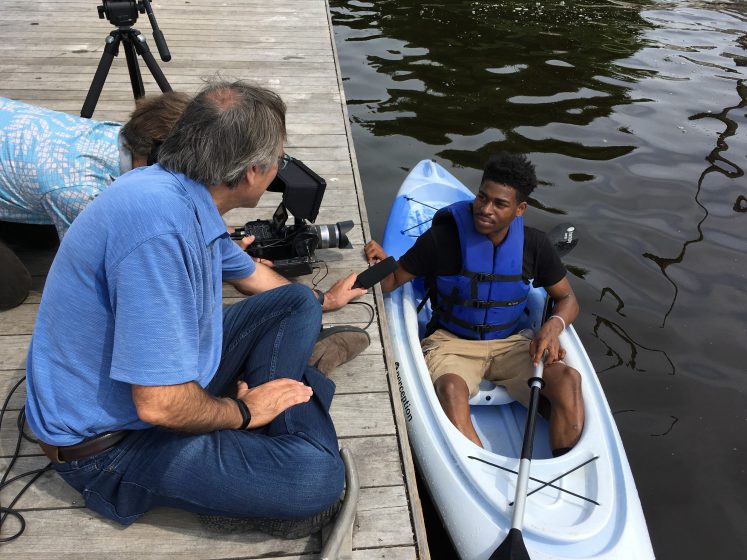
The medium of film allows the telling of stories visually and also often in impressive real time. You hope for, but are never sure you will find, unplanned spontaneous stories, people, voices along the way. We filmed one day at a neighborhood of floating homes in the IJBurg district of Amsterdam. Walking along with the developer of these homes we encountered a new residents, having just moved in. What was it like to live in a home that was floating, we asked? We were able to capture the interplay and conversation between an appreciative homeowner and the developer (who he did not know or recognize) who made it possible.
While filming in Miami Beach, a city already experiencing the impacts of sea level rise, we had a similar encounter. Filming in Sunset Harbor we sought to capture a sense of how the city’s efforts at elevating roads and investing in new pumping stations looked and felt like in this very sea-vulnerable location. We just happened to encounter a worker at one of the restaurants most affected. It was a personal moment of sharing about the uncertainty of the future of the city, the need to more aggressively tackle climate change for the sake of his kids and family, all at the doorway of a business that was oddly two-feet below the street. It was a striking juxtaposition of the engineered and the human, and something we did not and probably could not have planned. It was another advantage of celebrating the unscripted and being on the lookout for serendipitous encounters that make the film ever more interesting and personal.
Some of the most interesting stories we tell in the film have to do with creative ways to make the often invisible marine world visible to those living in cities. With this in mind we filmed one evening in Gig Harbor, Washington (about an hour’s drive south of Seattle), where a nonprofit called Harbor WildWatch had been organizing a series of monthly events called “Pier Into the Night”. It was a clever, low-tech way to engage the community in appreciating and learning about the underwater life all around them. Volunteer divers are sent underwater with a GoPro camera and lights to see what marine life can be discovered. These images are then displayed in real time on a screen on the town’s public pier. It was a magical evening and impressive that families with small kids were willing to endure a cold evening to watch what the divers were finding (all interpreted in real time by a Harbor WildWatch naturalist). To those who have heard about this it is an “AHA” moment—with a few volunteers and some inexpensive equipment, the underwater world of Puget Sound can be delivered in a compelling way to those (most of us) more terrestrial-bound human beings. But then, disappointingly, none of this footage made it into final film, highlighting a difficult reality: often it is too dark or the images too shaky to use. This might be corrected through acquiring file footage, but many shoots end up this way.
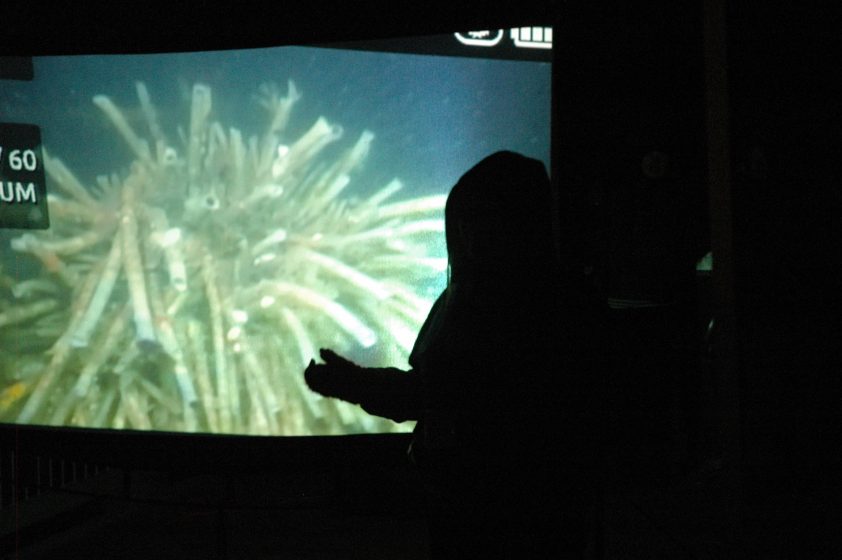
Perhaps my favorite shoot occurred in Miami (one that does end up in the film!), with a similar theme of uncovering the wondrous marine world. Just a few weeks after we had visited Gig Harbor we found ourselves wading into the Atlantic Ocean, with a group of highly charged fifth-graders. These kids were participating in a popular program called Seagrass Adventure, organized through the Marjory Stoneman Douglas Biscayne Nature Center.
Here the power of film shines especially. To see the rapt fascination of these young kids, most of whom though they lived only miles away, many from underserved neighborhoods, many had never experienced the ocean before. They tackled their assignment with ferocious courage, dipping and moving their nets along the bottom of the ocean and pulling to the surface a variety of marine organisms. The audible reactions at what they were seeing were remarkable. We came away from that day with the feeling that we had seen human transformation take place.
After about an hour in the water, and with each group’s floating bucket full of unusual and exotic (to us) creatures, the kids headed back to shore. There, the Center’s naturalists continued their work. The kids formed circles and the staff sent around in plastic containers some of what they had discovered. The kids learned more about the biology of these creatures and got an even closer longer look at what they had collected. These in-water activities are supplemented by extensive classroom talks and lab exercises, some of which we also filmed.

In our films we have also given a priority to voices of young people. In one of our New York City shoots we visited the Harbor School on Governors Island. We learned from several very enthusiastic students about the process for raising and growing young oysters, as they showed us around the aquaculture lab. The New York Harbor School–essentially a public high school specialized in developing maritime skills and careers–is a wonderful story itself, and its founder Murray Fisher spoke eloquently of its origins and value. As Fisher told us, New Yorkers are still “shockingly disconnected” from the harbor and the School has sought in some significant ways to address this. One of the most impressive is the Billion Oyster Project, which engages schools around the city in learning about, raising and deploying oysters in the Harbor. So far they have put a remarkable 20 million in the Harbor. There is a long way still to reach a billion, but progress have been great in engaging schools and others (including local restaurants in who donate badly needed oyster shells used in making new oyster beds).
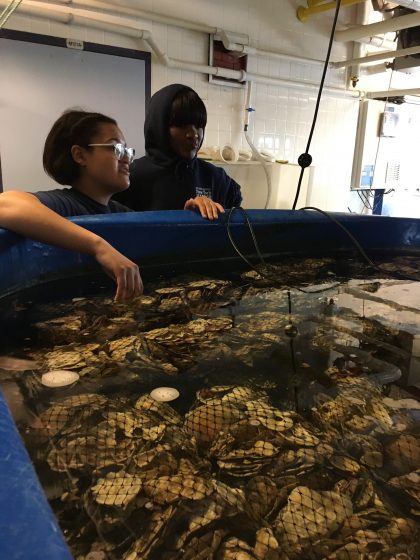
One of the key themes in the film is rethinking our approach to seafood. It is easy to muster experts and sometimes overly dry statistics (we need them of course), but film can tell the story in a more concrete, contextualized way. To this end we spent the day with a small scale fisher, Calder Deyerley, based in Moss Landing, on the Monterey Bay. It was about the merits of fishing quotas, and new mechanisms such as Community Supported Fisheries or CSFs (we profiled one of these in the film, Real Good Fish, also based at Moss Landing, through which of his harvest is sold), and other ways to support more sustainable local fishing practices, but it was more than that.
We stood on his small boat and listened to him talk about the meaning of fishing, his commitment to place and community, his pride in fishing and hopes that his five year old son (who was also there when we filmed) will be able to follow in his footsteps. It was a compelling visual and a compelling (and hopeful) story of an alternative fishing future, one that you wanted to root for.
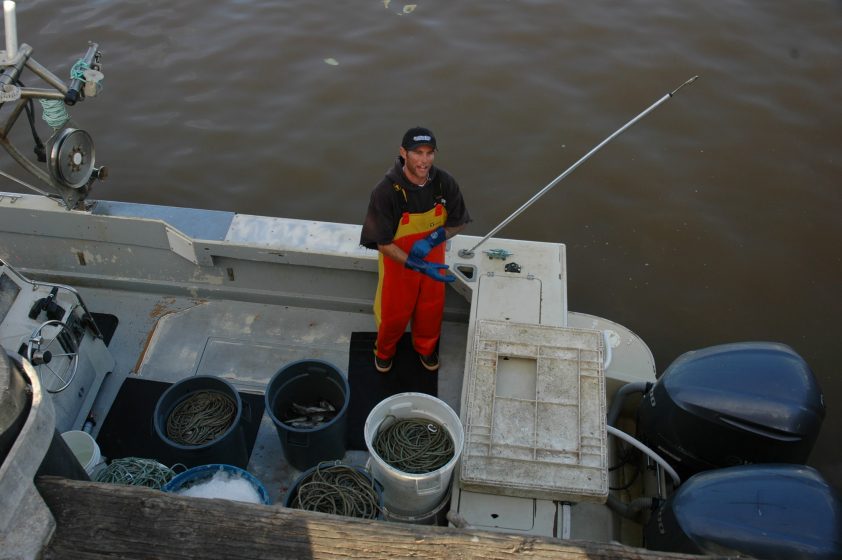
These onsite shoots are also educational opportunities for me, and I have found that I learn much from seeing, experiencing and conversing directly with those in the trenches. I also sometimes discover things that would be difficult to grasp or absorb in any other way. That day in Moss Landing I had a reaction that surprised me a bit, and one that caused some pondering for days afterwards. Towards the end of the day we waited for Calder to return and to bring his day’s harvest into port. He arrived and after waiting his turn to offload the catch it appeared in several crates full of writhing fish.
Despite my strong feelings of support for what this principled fisher was doing I was still impacted by what I had not thought about before—the pain and suffering of these fish. Later I had the opportunity to speak by phone with Australia ethicist Peter Singer (for a column I was writing for Planning Magazine). With these reactions still percolating our conversation veered to the topic of ethics of food. Singer had been tracking for years the emerging research about the sentience and psychological complexity of fish (and thus their pain and suffering). There are clear ethical advantages, Singer says, to growing oysters and other bivalves (they lack, for instance, a central nervous system) as well as for kelp and seaweed harvesting (already on the rise). These are topics given scant attention in our film but that would be more prominent if we were to start over today (and perhaps will be included in the next film).[iii]
There are limitations to our particular style of filmmaking. to be sure. One is that we often sample so many stories and places that there is little room for in-depth or detailed treatment. Experiencing visually, and perhaps experiencing vicariously (through my eyes) a project such as the immense Maeslant Barrier in Rotterdam, an immense floodgate longer than the Eiffel Tower is tall, is a conscious trade off: A full discussion of the merits and operation of this flood gate would require an hour-long film, but to see it, to get a sense visually of its size and magnitude nevertheless has some power.
One of my own strategies has been to take the extensive taped interviews and to use them to, in part, produce parallel books. In the case of Ocean Cities, more detail about many of the people, projects and organizations highlighted in the film can be found in a 2018 book (called Blue Biophilic Cities, published by Palgrave MacMillian[iv]). In this case, it is a slim volume, but a demonstration of the idea that academics who dabble in filmmaking can often apply (some of) this material in more scholarly ways. There is an efficiency (and a synergy) between writing and documentary filmmaking that serve to extend the value of both.
There are other limitations of our method of filmmaking. One involves the choice of shoot locations. Ocean Cities has a heavy American orientation, and a decided Northern Hemisphere outlook about what is possible in response to sea level rise. It has been rightly observed that climate adaptation in the less-affluent cities of the Global South are more constrained and often raise more serious issues of equity and social justice (I especially recommend Lizzie Yarina’s insightful essay “Your Seawall WIll Not Save You”[v]).
And it is a legitimate question whether the experiences of Rotterdam, highly touted around the world, and given yet more visibility in our film, are relevant in other cities. Indeed there is a risk in generalizing such ideas such as “water plazas,” and failing to appreciate the important ways in which sea level rise adaptation ideas and strategies must be locally indigenous. Nevertheless, we are already seeing how the Rotterdam story stimulates thinking about what can be designed and built in other cities, with a necessary dose of local or regional adaptation.
Despite these limitations the potential to make wonderful (low-cost) documentary films, that tell compelling stories, and that captivate and fascinate, and hopefully to motivate, is great indeed. In the case of Ocean Cities we hope the film helps in a small way to shift our terrestrial biases, to see the watery nature around us in new and more appreciative ways. There is both delight and danger in coastal cities and we must continue to press for creative approaches (especially in city planning) that deftly navigate between these two realities.
Tim Beatley
Charlottesville
Notes:
[i] Timothy Beatley, Blue Urbanism: Exploring Connections Between Cities and Oceans, Washington, DC: Island Press, 2014.
[ii] For more about the Living Breakwaters project see Orff’s excellent new book Toward an Urban Ecology, Monacelli Press , 2016; This book was recently reviewed in TNOC here:
[iii] Singer has done some writing on this topic, for instance: “Fish: the forgotten victims on our plate,” The Guardian, September 14, 2010, found at: https://www.theguardian.com/commentisfree/cif-green/2010/sep/14/fish-forgotten-victims
[iv] Timothy Beatley, Blue Biophilic Cities: Nature and Resilience Along the Urban Coast, Palgrave-MacMillian, 2018.
[v] Lizzie Yarina, “Your Seawall Will Not Save You, Places Journal, March, 2018, found at: https://placesjournal.org/article/your-sea-wall-wont-save-you/

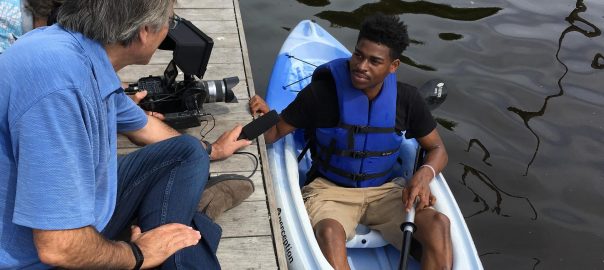






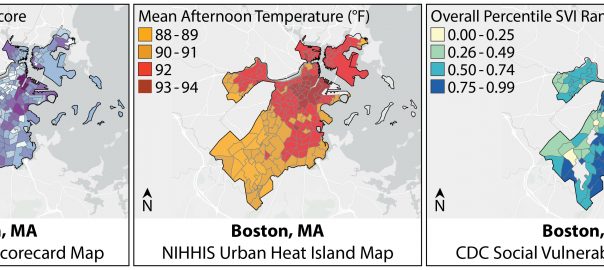



Add a Comment
Join our conversation